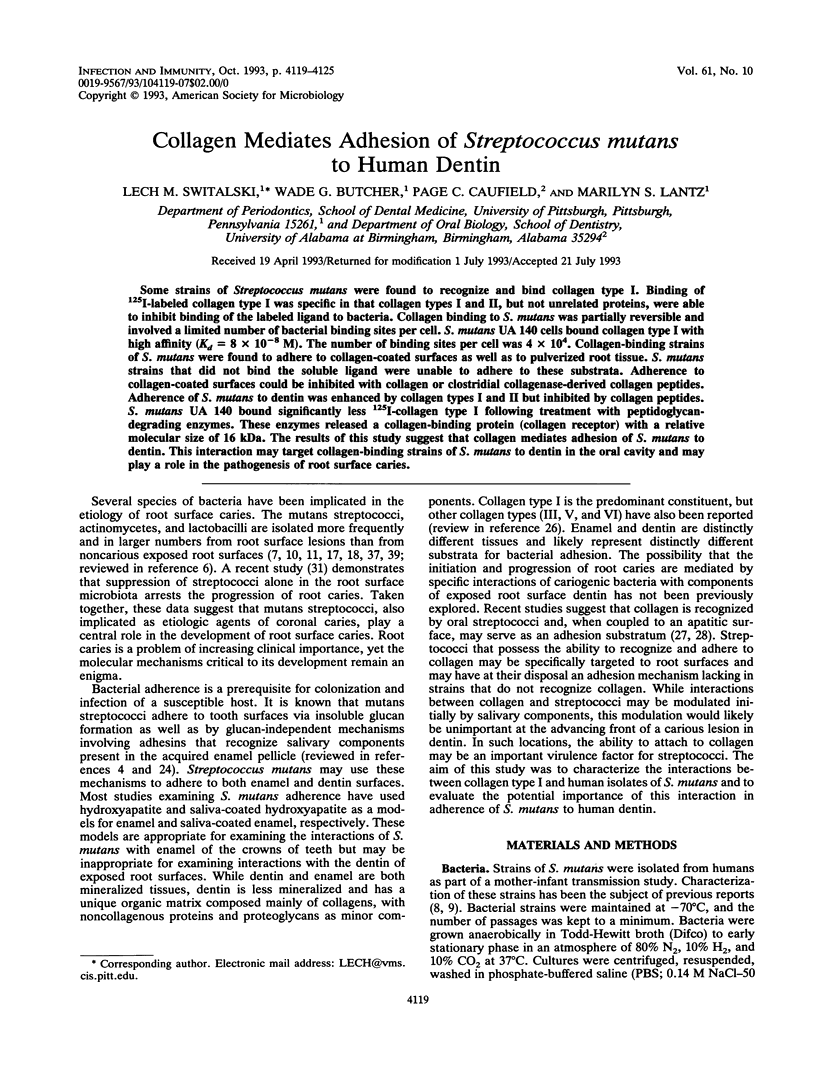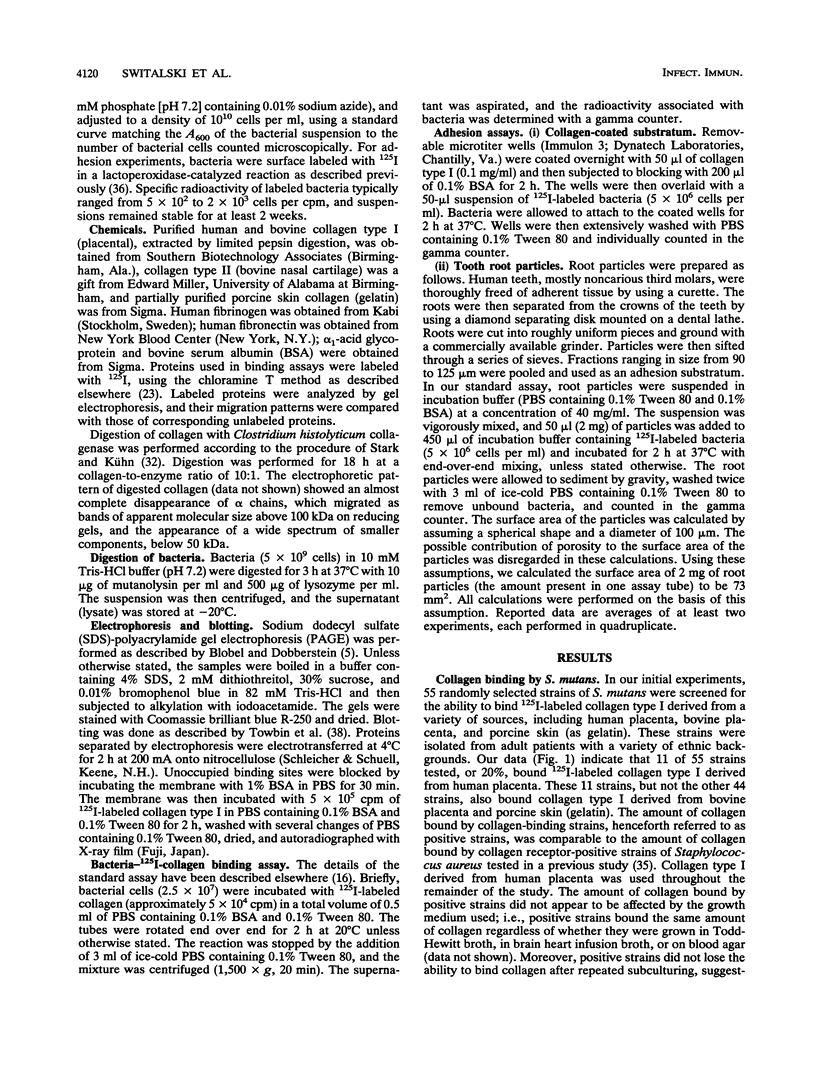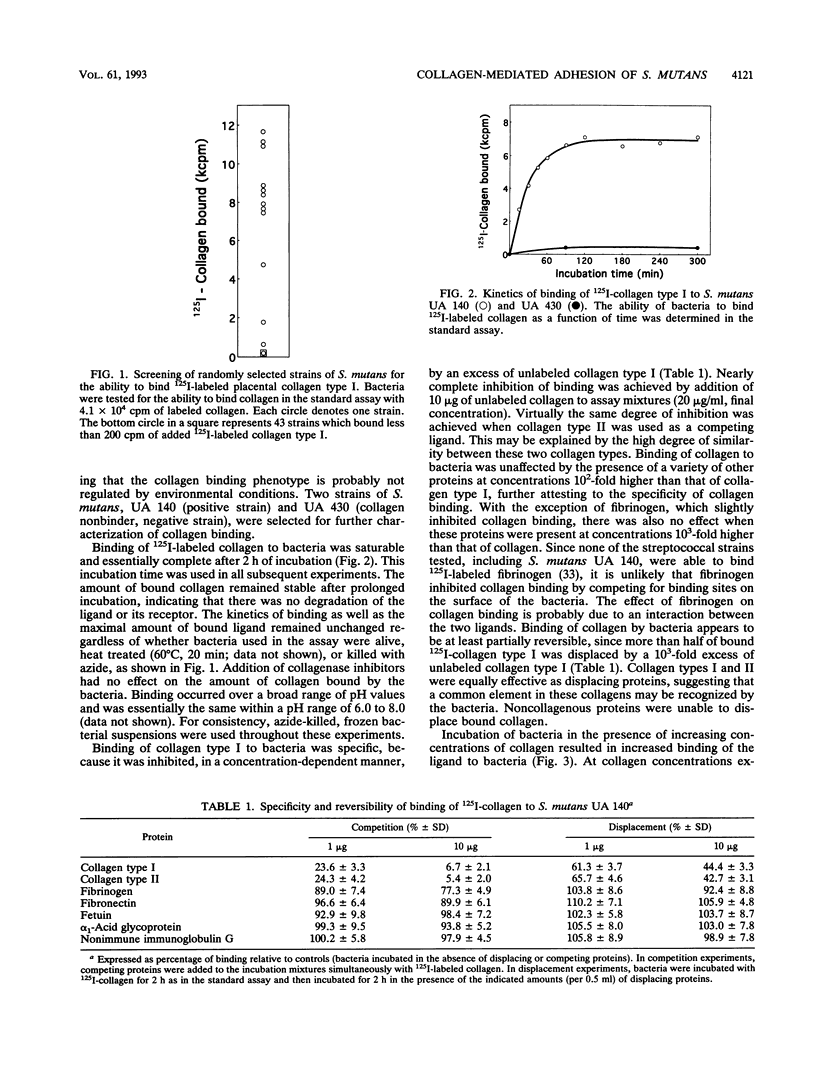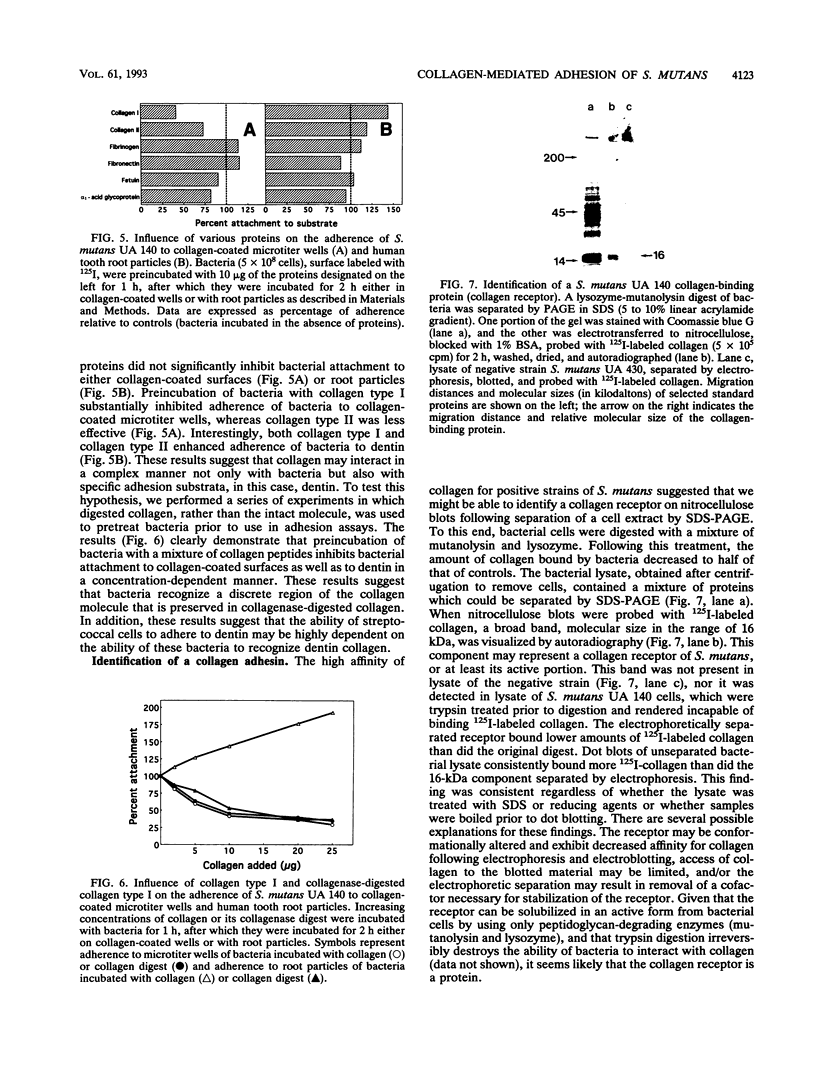Abstract
Some strains of Streptococcus mutans were found to recognize and bind collagen type I. Binding of 125I-labeled collagen type I was specific in that collagen types I and II, but not unrelated proteins, were able to inhibit binding of the labeled ligand to bacteria. Collagen binding to S. mutans was partially reversible and involved a limited number of bacterial binding sites per cell. S. mutans UA 140 cells bound collagen type I with high affinity (Kd = 8 x 10(-8) M). The number of binding sites per cell was 4 x 10(4). Collagen-binding strains of S. mutans were found to adhere to collagen-coated surfaces as well as to pulverized root tissue. S. mutans strains that did not bind the soluble ligand were unable to adhere to these substrata. Adherence to collagen-coated surfaces could be inhibited with collagen or clostridial collagenase-derived collagen peptides. Adherence of S. mutans to dentin was enhanced by collagen types I and II but inhibited by collagen peptides. S. mutans UA 140 bound significantly less 125I-collagen type I following treatment with peptidoglycan-degrading enzymes. These enzymes released a collagen-binding protein (collagen receptor) with a relative molecular size of 16 kDa. The results of this study suggest that collagen mediates adhesion of S. mutans to dentin. This interaction may target collagen-binding strains of S. mutans to dentin in the oral cavity and may play a role in the pathogenesis of root surface caries.
Full text
PDF






Images in this article
Selected References
These references are in PubMed. This may not be the complete list of references from this article.
- Babu J. P., Beachey E. H., Hasty D. L., Simpson W. A. Isolation and characterization of a 60-kilodalton salivary glycoprotein with agglutinating activity against strains of Streptococcus mutans. Infect Immun. 1986 Feb;51(2):405–413. doi: 10.1128/iai.51.2.405-413.1986. [DOI] [PMC free article] [PubMed] [Google Scholar]
- Babu J. P., Dabbous M. K. Interaction of salivary fibronectin with oral streptococci. J Dent Res. 1986 Aug;65(8):1094–1100. doi: 10.1177/00220345860650081001. [DOI] [PubMed] [Google Scholar]
- Babu J. P., Simpson W. A., Courtney H. S., Beachey E. H. Interaction of human plasma fibronectin with cariogenic and non-cariogenic oral streptococci. Infect Immun. 1983 Jul;41(1):162–168. doi: 10.1128/iai.41.1.162-168.1983. [DOI] [PMC free article] [PubMed] [Google Scholar]
- Bleiweis A. S., Oyston P. C., Brady L. J. Molecular, immunological and functional characterization of the major surface adhesin of Streptococcus mutans. Adv Exp Med Biol. 1992;327:229–241. doi: 10.1007/978-1-4615-3410-5_25. [DOI] [PubMed] [Google Scholar]
- Blobel G., Dobberstein B. Transfer of proteins across membranes. I. Presence of proteolytically processed and unprocessed nascent immunoglobulin light chains on membrane-bound ribosomes of murine myeloma. J Cell Biol. 1975 Dec;67(3):835–851. doi: 10.1083/jcb.67.3.835. [DOI] [PMC free article] [PubMed] [Google Scholar]
- Bowden G. H. Microbiology of root surface caries in humans. J Dent Res. 1990 May;69(5):1205–1210. doi: 10.1177/00220345900690051701. [DOI] [PubMed] [Google Scholar]
- Brown L. R., Billings R. J., Kaster A. G. Quantitative comparisons of potentially cariogenic microorganisms cultured from noncarious and carious root and coronal tooth surfaces. Infect Immun. 1986 Mar;51(3):765–770. doi: 10.1128/iai.51.3.765-770.1986. [DOI] [PMC free article] [PubMed] [Google Scholar]
- Caufield P. W., Childers N. K., Allen D. N., Hansen J. B. Distinct bacteriocin groups correlate with different groups of Streptococcus mutans plasmids. Infect Immun. 1985 Apr;48(1):51–56. doi: 10.1128/iai.48.1.51-56.1985. [DOI] [PMC free article] [PubMed] [Google Scholar]
- Caufield P. W., Ratanapridakul K., Allen D. N., Cutter G. R. Plasmid-containing strains of Streptococcus mutans cluster within family and racial cohorts: implications for natural transmission. Infect Immun. 1988 Dec;56(12):3216–3220. doi: 10.1128/iai.56.12.3216-3220.1988. [DOI] [PMC free article] [PubMed] [Google Scholar]
- Ellen R. P., Banting D. W., Fillery E. D. Longitudinal microbiological investigation of a hospitalized population of older adults with a high root surface caries risk. J Dent Res. 1985 Dec;64(12):1377–1381. doi: 10.1177/00220345850640121001. [DOI] [PubMed] [Google Scholar]
- Emilson C. G., Klock B., Sanford C. B. Microbial flora associated with presence of root surface caries in periodontally treated patients. Scand J Dent Res. 1988 Feb;96(1):40–49. doi: 10.1111/j.1600-0722.1988.tb01406.x. [DOI] [PubMed] [Google Scholar]
- Espersen F., Clemmensen I. Clumping of Staphylococcus aureus by human fibronectin. Acta Pathol Microbiol Scand B. 1981 Oct;89(5):317–321. doi: 10.1111/j.1699-0463.1981.tb00195_89b.x. [DOI] [PubMed] [Google Scholar]
- Fietzek P. P., Piez K. A. Isolation and characterization of the cyanogen bromide peptides from the alpha 2 chain of rat skin collagen. Biochemistry. 1969 May;8(5):2129–2133. doi: 10.1021/bi00833a052. [DOI] [PubMed] [Google Scholar]
- Frank R. M., Steuer P., Hemmerle J. Ultrastructural study on human root caries. Caries Res. 1989;23(4):209–217. doi: 10.1159/000261180. [DOI] [PubMed] [Google Scholar]
- Fröman G., Switalski L. M., Faris A., Wadström T., Hök M. Binding of Escherichia coli to fibronectin. A mechanism of tissue adherence. J Biol Chem. 1984 Dec 10;259(23):14899–14905. [PubMed] [Google Scholar]
- Fröman G., Switalski L. M., Speziale P., Hök M. Isolation and characterization of a fibronectin receptor from Staphylococcus aureus. J Biol Chem. 1987 May 15;262(14):6564–6571. [PubMed] [Google Scholar]
- Fure S., Romaniec M., Emilson C. G., Krasse B. Proportions of Streptococcus mutans, lactobacilli and Actinomyces spp in root surface plaque. Scand J Dent Res. 1987 Apr;95(2):119–123. doi: 10.1111/j.1600-0722.1987.tb01817.x. [DOI] [PubMed] [Google Scholar]
- Fure S., Zickert I. Root surface caries and associated factors. Scand J Dent Res. 1990 Oct;98(5):391–400. doi: 10.1111/j.1600-0722.1990.tb00990.x. [DOI] [PubMed] [Google Scholar]
- Hawiger J., Timmons S., Strong D. D., Cottrell B. A., Riley M., Doolittle R. F. Identification of a region of human fibrinogen interacting with staphylococcal clumping factor. Biochemistry. 1982 Mar 16;21(6):1407–1413. doi: 10.1021/bi00535a047. [DOI] [PubMed] [Google Scholar]
- Hofmann H., Voss T., Kühn K., Engel J. Localization of flexible sites in thread-like molecules from electron micrographs. Comparison of interstitial, basement membrane and intima collagens. J Mol Biol. 1984 Jan 25;172(3):325–343. doi: 10.1016/s0022-2836(84)80029-7. [DOI] [PubMed] [Google Scholar]
- Kuramitsu H. K. Virulence factors of mutans streptococci: role of molecular genetics. Crit Rev Oral Biol Med. 1993;4(2):159–176. doi: 10.1177/10454411930040020201. [DOI] [PubMed] [Google Scholar]
- Linde A. Dentin matrix proteins: composition and possible functions in calcification. Anat Rec. 1989 Jun;224(2):154–166. doi: 10.1002/ar.1092240206. [DOI] [PubMed] [Google Scholar]
- Liu T., Gibbons R. J. Binding of streptococci of the "mutans" group to type 1 collagen associated with apatitic surfaces. Oral Microbiol Immunol. 1990 Jun;5(3):131–136. doi: 10.1111/j.1399-302x.1990.tb00410.x. [DOI] [PubMed] [Google Scholar]
- Liu T., Gibbons R. J., Hay D. I. Streptococcus cricetus and Streptococcus rattus bind to different segments of collagen molecules. Oral Microbiol Immunol. 1990 Jun;5(3):143–148. doi: 10.1111/j.1399-302x.1990.tb00412.x. [DOI] [PubMed] [Google Scholar]
- Nyvad B., Fejerskov O. An ultrastructural study of bacterial invasion and tissue breakdown in human experimental root-surface caries. J Dent Res. 1990 May;69(5):1118–1125. doi: 10.1177/00220345900690050101. [DOI] [PubMed] [Google Scholar]
- Schaeken M. J., Keltjens H. M., Van Der Hoeven J. S. Effects of fluoride and chlorhexidine on the microflora of dental root surfaces and progression of root-surface caries. J Dent Res. 1991 Feb;70(2):150–153. doi: 10.1177/00220345910700021101. [DOI] [PubMed] [Google Scholar]
- Stark M., Kühn K. The properties of molecular fragments obtained on treating calfskin collagen with collagenase from Clostridium histolyticum. Eur J Biochem. 1968 Dec 5;6(4):534–541. doi: 10.1111/j.1432-1033.1968.tb00477.x. [DOI] [PubMed] [Google Scholar]
- Switalski L. M., Patti J. M., Butcher W., Gristina A. G., Speziale P., Hök M. A collagen receptor on Staphylococcus aureus strains isolated from patients with septic arthritis mediates adhesion to cartilage. Mol Microbiol. 1993 Jan;7(1):99–107. doi: 10.1111/j.1365-2958.1993.tb01101.x. [DOI] [PubMed] [Google Scholar]
- Switalski L. M., Speziale P., Hök M. Isolation and characterization of a putative collagen receptor from Staphylococcus aureus strain Cowan 1. J Biol Chem. 1989 Dec 15;264(35):21080–21086. [PubMed] [Google Scholar]
- Switalski L. M., Speziale P., Hök M., Wadström T., Timpl R. Binding of Streptococcus pyogenes to laminin. J Biol Chem. 1984 Mar 25;259(6):3734–3738. [PubMed] [Google Scholar]
- Syed S. A., Loesche W. J., Pape H. L., Jr, grenier E. Predominant cultivable flora isolated from human root surface caries plaque. Infect Immun. 1975 Apr;11(4):727–731. doi: 10.1128/iai.11.4.727-731.1975. [DOI] [PMC free article] [PubMed] [Google Scholar]
- Towbin H., Staehelin T., Gordon J. Electrophoretic transfer of proteins from polyacrylamide gels to nitrocellulose sheets: procedure and some applications. Proc Natl Acad Sci U S A. 1979 Sep;76(9):4350–4354. doi: 10.1073/pnas.76.9.4350. [DOI] [PMC free article] [PubMed] [Google Scholar]
- Van Houte J., Jordan H. V., Laraway R., Kent R., Soparkar P. M., DePaola P. F. Association of the microbial flora of dental plaque and saliva with human root-surface caries. J Dent Res. 1990 Aug;69(8):1463–1468. doi: 10.1177/00220345900690080301. [DOI] [PubMed] [Google Scholar]



